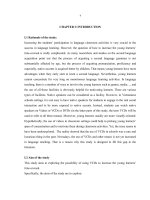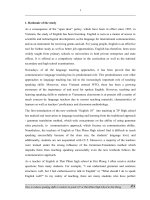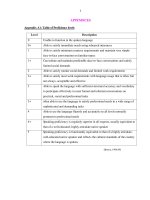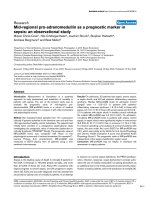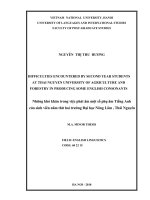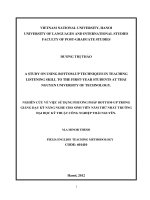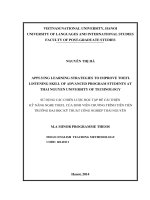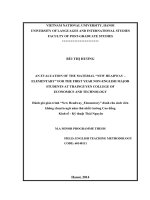Technology as a motivating factor to students an exploratory study at thai nguyen college of mechanics and metallurgy
Bạn đang xem bản rút gọn của tài liệu. Xem và tải ngay bản đầy đủ của tài liệu tại đây (338.18 KB, 10 trang )
Technology as a motivating factor to students:
an exploratory study at thai nguyen college of
mechanics and metallurgy
Trần Thùy Dung
Trường Đại học KHXH&NV
Luận văn ThS. Chuyên ngành:English Teaching methodology; Mã số: 60 14 10
Người hướng dẫn: Phạm Thị Ngọc Phượng
Năm bảo vệ:2010
Abstract: In language classrooms, being in unnatural conversational situations, students need
motivation more than other learning milieus. Teachers try to capture the attention of students
through various methods and techniques. Many researchers in EFL teaching profession have
stated that good motivation has appositive effect on foreign language learning. The purpose
of this study is to explore how technology impact on students’ motivation in EFL
classrooms.For this purpose; a questionnaire was administered to 100 first-year students and
6 language teachers at Thai Nguyen College of Mechanics and Metallurgy in 2009-2010
academic years. As a result it was found out that technology was a dynamic and challenging
motivating factor in EFL classrooms and there may be some suggestions for teachers and
administrators focusing on the achievement of teaching objectives
Keywords: Tiếng Anh; Phương pháp dạy học; Công nghệ thông tin; Hứng thú học tập.
Content:
TABLE OF CONTENTS
PART I: INTRODUCTION 1
1. Rationale 1
2. The aims of the study 1
3. Scope of the study 2
4. Research questions 2
5. The methods of the study 3
6. Significance of the study 3
7. Overview of the thesis 4
PART II: DEVELOPMENT 5
CHAPTER I: THEORETICAL BACKGROUND OF THE STUDY 5
I.1. Education technology and EFL teaching and learning 5
I.2. Computer uses for language teaching and learning. 6
I.3. Applications of technology (IT) in EFL. 8
I.4. Benefits of using Technology in EFL 11
I.5. Motivation in learning English 12
I.6. Effects of Technology on Motivation in EFL. 13
I.7. Limitations of using computer in EFL teaching and learning 15
I.8. Considerations of computer-assisted EFL teaching and learning. 16
CHAPTER II: THE STUDY 17
II. 1. The setting of the study 17
II. 2. Procedure 17
II. 2. 1. Methodology 17
II. 2. 1. 1. Subjects 17
II. 2. 1. 2. Instrumentation 18
II. 2. 2. Data analysis 18
II. 2. 3. Findings 31
II. 2. 4. Implications 33
CHAPTER III: RECOMENDATIONS 35
III. 1. For the administrators 35
III. 2. For the teachers 35
PART III: CONCLUSION 36
I. Conclusion and limitations 36
II. Further directions 36
References 37
Appendices I
PART I: INTRODUCTION
1. Rationale
For centuries foreign language teaching approaches, methods and techniques have
been changing because of different factors. Learning a foreign language is a challenging
process and students always need motivation and encouragement during this period.
Technology might be one of the factors which affects students’ attitude positively in the
teaching/ learning process. Adiyaman (2002) defines one way of technological
equipment such as radio, TV, cassettes, CD, DVD and two way of educational
technological equipment used in EFL classrooms like e-mails, computers, interactive
radio and television programs, teleconference and internet conferences.
In the process of teaching and learning a foreign language, learners are always
the most important factors. To be successful or get failure in understanding well or
owning the language bases on the thing how the learners can use or work with that
process. It is the very thing that foreign language learners have not acquired as they
expected at the beginning of time.
We are living in the era of explosion in information technology. The foreign
language training supported by Internet technology has appeared at the university level,
secondary schools and vocational training in many countries around the world. Vietnam
at the application of technology in teaching in schools is also on the momentum of
development. Teaching English in Vietnam, especially in Thai Nguyen College of
Mechanics and Metallurgy where students are specializing in the field of Mechanics, is
considered as an interesting but challenging job. Today, learning and teaching English
through the computer and learning how to use computer proficient in English through
the trends in the foreign language training.
In the field of language education, a great deal of emphasis now focuses on
using technology (IT) in ETL. The application of ICT (Information and Communication
technology) in the language classroom is one of new methods in renovating methods of
teaching methodology of Vietnamese Ministry of Education and Training.
2. The aims of the study:
The study aims to reach the following targets:
- to investigate the teachers’ application of technology in order to find the
advantages, disadvantages of the teachers in using technology in teaching English for
freshman students of Mechanics department at (TCMM) Thai Nguyen College of
Mechanics and Metallurgy.
- to investigate the role of technology on motivation in the language classrooms and
to review the students’ ideas on how to use technological equipment effectively.
- to discover how IT influences the students’ learning English, their feedbacks
towards the use of technology in classroom instructions.
- to propose some recommendations for administrators, teachers in improving the
quality of teaching and learning English at Thai Nguyen College of Mechanics and
Metallurgy.
3. Scope of the study
Due to the limited time, the author only focuses on using technology in
teaching English to freshmen students of Mechanics department at TCMM because most
students of Mechanics department are at low level, they are uninterested in learning
English; they are usually failed in the English exams. It is the main reason why they do
not like learning English subject. The purpose of using IT in teaching English at TCMM
in order to make the lessons easier and more interesting to learn by presenting the
difficult structures and terms popularly will be used in Mechanics with the assistance of
Projector, searching information on the internet.
This study aimed at using IT in teaching for Freshman Mechanics Majors at
Thai Nguyen College of Mechanics and Metallurgy. The respondents of the study will
be 100 freshmen students of the two classes (CK 47 A, B). The research will be
conducted during the time of the second semester 2009-2010, from December to April in
2009 – 2010.
4. Research questions
In odder to achieve the aims mentions in section 2, the present study focused on
answering the research question: How does IT help to motivate students in learning
English at TCMM?
More specifically, it aimed to address the following sub-questions:
i. How is IT used in teaching and learning English at TCMM?
ii. Do students get motivated by the use of the technology in learning process?
iii.Are students and teachers aware of technology application in teaching and
learning English?
iv. What suggestions do students and teachers have for organization and language
teachers?
5. Methods of the study
The method used in this study is exploratory research design which utilizes
qualitative data collection techniques with an aim to answer the research questions. To
conduct the study, the author will carry out two surveys on six English teachers at
TCMM and 100 freshman students of Mechanics department at TCMM. Questionnaires
were sent to six teachers who have taught students of Mechanics department and 100
freshman students who were selected from two classes (CK47 A, B) of Mechanics
department. The questionnaire was designed to find out the role of technology on the
motivation of EFL learners in language classes and to put forward some practical ideas
in order to make language learning more effective. The aims of survey is to reveal how
teachers use technology in EFL classrooms, their problems when working with
computer, if there might be, and their needs for better use of computer in the classroom.
6. Significance of the study
Teaching English is one of the main responsibilities and priorities of Vietnam
Educational System. This study implements to find the way to improve capabilities of
students in learning language. The big problem of the freshman students at TCMM is
that most of the students are low-motivated. Besides, the problem of what to teach, how
to teach and what is the teachers’ way to motivate their students. There are some
significances of the study:
Educational Controllers. The results of this study will make this group of
people aware of the importance of using information technology to take it into the
curriculum program in teaching English at TCMM.
English Language Teachers. The study will also make English language
teachers identify that the application IT is more effective in teaching English for
freshmen students. (Most freshman students are non-major English learners).
Students. Especially, it will help them be interested in English and not be
afraid of learning English and they will find themselves more confident and motivate in
spending time on learning English.
7. Overviews of the thesis:
The study consists of the following chapters:
Part I - Introduction: introduces the rationale for the research, the aims, the
scope, and the research questions of the study, the methods, the significance and the
organization of the study.
Part II – Development: includes three chapters:
Chapter I- Literature review: reviews the theoretical background to Education technology
and EFL teaching and learning , the applications of technology in ELT, benefits of using
technology in ELT, effects of technology on motivation in EFL, the limitations of using
technology in ELT, and some considerations using technology in ELT.
Chapter II – The study: discusses the detailed methodology to do the research. It
comprises participants, instrumentation, and data collection. Next, presents in details the
data analysis, findings and implications of the study.
Chapter III – Recommendations: concerns the researcher’s recommendations and
suggestions for enhancing the effectiveness of using technology in ELT.
Part III – Conclusion: summarizes the main ideas expressed throughout the
research, analyzes limitation of the paper and suggests further research orientations.
REFERENCES
1) Adiyaman, Z. (2002). Foreign language teaching via distance education, TOJET. 1.
Issue 1.
2) Allen, M. (1995). Email in Writing Class: Promoting Student Communication.
ERIC:ED 394 348, 2.
3) Australian Language and Literacy Council. (1996) the Implications of Technology for
Language Teaching. Canberra. Australian Government Publishing Service.
4) Brierley, W and Kemble, I.R. (1991) Computers as a tool in language teaching. Ellis
Horwood Upper Saddle River, NJ, USA. 3. p17.
5) Brown, D (2000). Principles of language learning and teaching ( 4
th
ed.). While
plains, NY: Peason Education.
6) Brown, D. (2003). Developing faculty to use technology .Balton, Anker Publishing
Company.
7) Case, C & D. Truscott. (1999). The lure of bells and whistles; choosing the best
software to support reading instruction reading and writing quarterly. Overcoming
Learning Difficulties. 15-19.
8) Corrêa, D.M. New technologies in teaching and learning English. In: FORTKAMP,
M.B.M.; XAVIER, R.P. (Ed.). EFL Teaching and learning in Brazil: theory and
practice. Florianópolis: Insular, 2001. p. 211-222.
9) Crystal, D. (1997). English as a global language. Cambridge, Cambridge University
Press. Demiray, U and Sever, S. (2009). The challenges for marketing distance
education in online environment. Eskisehir: Anadolu University. 157.
10) Cuban, L. (2001). Oversold and Underused: Computers in the Classroom. Cambridge,
Mass: Harvard University Press.
11) Davies G. (1999) The Internet: an introduction for language teachers. Retrieved Jan
26
th
, 2010, from
12) Egbert, J. (2004). Two faces of Technology use. Essential Teacher. Spring 2004 Vol.
13) Ellis, R. (1994). The study of second language acquisition. Oxford, Oxford University
Press.
14) Ellinger, B. S, Sandler, D. D, Chayen. K, Goldfrad. J, Yarosky. (2001).Weaving the
web into an EAP reading program. English Teaching Forum. April.
15) Gardner, R, C (2006) Intergrative motivation and second language acquisition.
16) Garrett, N. (1991). Technology in the service of language learning: Trends and issues.
Modern Language Journal 75(1), 74-101.
17) Galavis, B. (1998). Computers and the EFL Class: Their Advantages and a Possible
Outcome, The Autonomous Learner. English Teaching Forum, 36 (4), p27.
18) Harmer J (2001), “The practical of English Language Teaching”, 3
rd
ed., Longman,
Harlow.
19) Harmer, J. (2007). The practice of English language teaching. Pearson Longman.
20) Jonassen, D. H. (2000). Computers as mind tools for schools: Engaging critical
thinking. Upper Saddle River, NJ: Prentice Hall.
21) Kang, S. (1999). Learning styles: Implications for ESL/EFL instruction: English
Teaching Forum. 37-40.
22) Lee, K. (2006) English teacher‟s barrier to the use of computer- assisted language
learning. The Internet TESL Journal. At: <
Callbarriers.html>, accessed on: 26 Jan. 2010.
23) Lin, A (2003). An Initial Study on EFL learners‟ Attitude toward Multimedia
Application in language learning. Teaching English with Technology Journal, 3(2).
Retrieved Jun 26
th
, 2010, from http:/www.iatefl.org.pl/j_article13.htm
24) Lundin, R. (1993) Overseas Experience in Non-traditional modes of Delivery in
Higher education using State-of-the-Art Technologies. Best Practice. Australian
Government Publishing Service, Canberra.
25) MacDonald, G. J. (2004). Contrarian finding: Computers are a drag on learning.
Retrieved January 26, 2010, from the World Wide Web,
26) Matsuo, M. (1996). Changes in Japanese College Students’ Attitudes toward EFL
Classroom through Dialogue Journal Writings. Memoirs of Senzoku-Gakuen College,
25.33.
27) Nguyen Lan Trung (2002), “The classrooms of Tomorrow”, Ky yeu Hoi thao Quoc te:
Giao duc ngoai ngu – Hoi nhap va phat trien, p.61-65.
28) Oppenheimer, T. (1997). The computer delusion. The Atlantic Monthly 280 (1), 45-62.
29) Oppenheimer, T. (2003). The Flickering Mind: The False Promise of Technology in
the Classroom and How Learning can be saved. New York: Random House.
30) Singhal, M. ( 1996) The internet and foreign language education: benefits and
challenges. accessed on: 26 Jan. 2010.
31) Spolsky, B. (1989). Conditions for second language learning. Oxford: Oxford
University Press, p. 160.
32) Tognato, M.I.R. Rethinking the teacher‟s role and the process of insertion of
technology in the classroom. In: FORTKAMP, M.B.M.; XAVIER, R.P. (Ed.). EFL
teaching and learning in Brazil: theory and practice. Florianópolis: Insular, 2001. p.
203-210. Received on February 13, 2007. Accepted on May 03, 2007.
33) Warschauer, M. (1995). Email for English Teaching. VA: TESOL, Inc.
34) Warschauer, M. and Meskill, C. (2000) Technology and Second Language Teaching
and Learning. in J. Rosenthal (ed) Handbook of Undergraduate Second Language
Education. Mahwah, NJ: Lawrence Erlbaum.
35) Wang, Y. (2004). English magazines, motivation+ improved EFL writing skill. English
Teaching Forum. January.
36) Zengin, R. (2007). A research about the English language teachers„ use of
instructional technologies in Turkey. Journal of the Hasan Ali Yücel Faculty of
Education. October.
